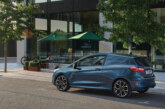
Electric and hybrid LCVs are a solid step towards a greener future. However, without the rumble of a petrol or diesel engine, these silent vehicles can pose a danger to pedestrians. In response, new legislation will be introduced later on this year.
At low speeds, electric and hybrid vehicles can be dangerous on the roads because they are so quiet at low speeds. Without the purr of a petrol or diesel engine to warn them, pedestrians are less likely to notice the approach of an EV than of a conventional vehicle. This is about to change.
From 1st September 2019, all new models of hybrid and pure electric vehicles must by law be fitted with an Acoustic Vehicle Alerting System (AVAS) that emits a continuous sound when the vehicle is travelling at speeds of up to 20km/h. This will be extended to all new electric and hybrid vehicles registered after 1st September 2021.
The United Nations Economic Commission for Europe’s World Forum for Harmonisation of Vehicle Regulations (WP.29), which is responsible for rules governing Vehicle Type Approvals, set the standard for AVAS in its Regulation for Quiet Road Transport Vehicles.
The new regulation is being brought in to protect vulnerable road users, particularly blind and partially-sighted people who depend, more than most of us, on hearing traffic to judge when it is safe to cross the road. However, what it doesn’t account for is the 200,000 plus electric vehicles which are currently on Britain’s roads, each posing a hazardous risk to VRUs (vulnerable road users).
Safety pioneer, Chris Hanson-Abbott OBE, Chairman of Brigade Electronics, which has spent the past nine years developing a Quiet Vehicle Sounder that mimics the vital warning characteristics of an internal combustion engine, said, “It’s not a moment too soon – in fact it is not soon enough!
“Visually impaired people will still be at risk because there are already electric and hybrid vehicles on the road that are virtually silent at low speeds. These are putting lives in danger. We are all taught to listen as well as look out for traffic and the background noise in busy streets will mask any slight sound an EV may make when moving off.
“Owners of ‘silent’ vehicles really ought to be aware of the danger and fit a Quiet Vehicle Sounder if they want to avoid unnecessary accidents. Nobody wants to knock down a pedestrian.”
A study in America found that electric and hybrid vehicles double the risk of accidents with pedestrians when executing slow manoeuvres such as starting in traffic, slowing down, reversing, entering, or leaving a driveway or parking space.
Similarly, the risk of accidents is raised by 80% when turning corners and by 50% at speeds of less than 35mph. In the UK, another study commissioned by Guide Dogs for the Blind found that pedestrians are 40% more likely to be hit by an electric vehicle than a diesel or petrol one.
Whilst there are a few OEM’s fitting AVAS in cars, Brigade’s Quiet Vehicle Sounder can be retro-fitted to any vehicle and is suitable for buses, minibuses, coaches, HGVs and, significantly, light commercial vans which are growing in numbers on Britain’s roads.
Developed after listening to the needs of vulnerable road users, the QVS emits a sound that is highly directional, making it easy to locate the vehicle, and which also changes with the speed of the vehicle so pedestrians can judge how much time they have to get out of the way.
Legislation details
New legislation, which comes into force in July 2019, will require the mandatory fitment of Acoustic Vehicle Alerting Systems (AVAS), for all new quiet (electric, hybrid and hydrogen fuel cell) vehicle models registered after 1st September 2019 and all new vehicle registrations after 1st September 2021.








